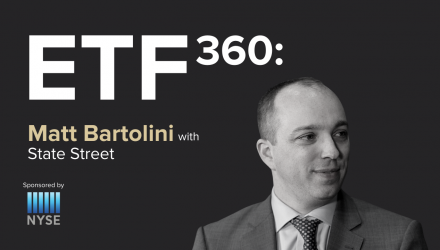ETF Trends CEO Tom Lydon and CIO Dave Nadig caught up with Matt Bartolini, Head of SPDR America’s Research at State Street Global Advisors, on this week’s episode of ETF 360 to discuss the low interest rate environment.
Watch the Full ETF 360 Episode Here:
When considering the upcoming year and what advisors should do with their portfolios, Bartolini suggests, based on the effect Covid-19 has had on social behavior and asset classes, it makes sense for investors to start taking some risks to get to a yield they used to have.
“There’s no free lunch with investing, and there’s definitely no free lunch with an income now that we are going towards 2021 in a very low rate environment,” Bartolini states.
As Nadig points out, when investors allocate to bonds, it seems to be largely taking place at the short end of the curve, noting SSGA’s current highest asset gather fund of 2020, the SPDR Bloomberg Barclays 1-3 Month T-Bill ETF (BIL). His concern is whether people are looking to other asset classes to avoid reaching out on the curve due to rising interest rates.
Send Over The BIL
Bartolini believes the inflows into BIL represent the volatility regime the market has remained in this year. Because of this, investors are seeking areas that can preserve capital. However, he does still agree that it is important to step out on the curve from an income perspective. It is important to balance whatever income is available for a reasonable risk level.
Lydon points out how the Fed is said not to be raising interest rates anytime soon, which should mean investors will be getting more aggressive. He wonders if it’s safe for those pushes to lead to areas such as junk bonds.
As Bartolini explains, “In order to get income, you have to take some risks. That’s the name of the game right now.” Of course, this can be within reason. For example, senior loans make more sense for high-income investors than high yield, based on the way potential recovery will play out and what the profit cycle will look like.
Switching gears to preferreds, an area where only a handful of ETFs actually tracks that part of the market, Nadig asks what could be done to best position them, given their somewhat unknowable status. Equity risk and defaults could be possible issues. However, Bartolini states how, while it is an equity, preferred stocks behave like bonds. They’re mainly issued by highly regulated markets like financials, which can severely change across the ETF ecosystem.
That in mind, Bartolini knows that for their funds, to be included, it has to be rated investment grade by one rating agency to have that investment grade profile. Plus, you can still get a yield normally equated to all high yield. Preferred mays still be a misunderstood asset class; however, people think they are equity sensitive, and findings show they have a lower equity sensitivity than high yield bonds.
This means an investor can increase their income and improve some of their diversification when considering it from the rest of the portfolio perspective.
For more ETF 360 videos, visit our ETF 360 Channel.
